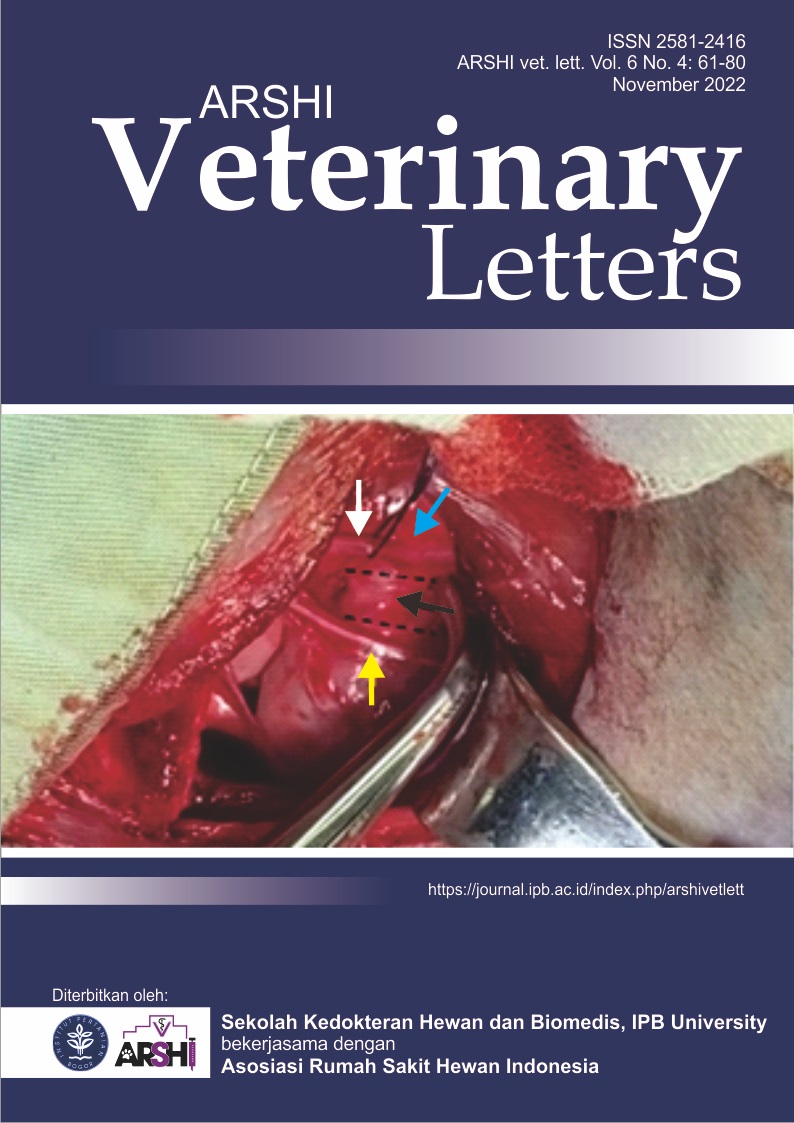Resistansi Escherichia coli asal feses sapi di wilayah Bogor terhadap antimikrob
Abstract
Resistansi bakteri terhadap antimikrob telah menjadi permasalahan global. Pengujian resistansi antimikrob bakteri dari hewan penting dilakukan terutama dengan adanya resistansi antimikrob pada manusia yang diduga bersumber pada ternak. Tujuan penelitian ini adalah untuk menganalisis gambaran resistansi Escherichia coli (E. coli) yang diisolasi dari feses sapi terhadap berbagai antimikrob, yaitu aztreonam, basitrasin, sefpodoksim, enrofloksasin, fosfomisin, gentamisin, dan kloramfenikol. Uji resistansi antimikrob dilakukan menggunakan metode difusi cakram Kirby-Bauer. Hasil uji diinterpretasi menurut Clinical and Laboratory Standards Institute (CLSI). Isolat E. coli asal feses sapi yang diperiksa resistan terhadap aztreonam (40%), sefpodoksim (40%), fosfomisin (50%), basitrasin (100%), dan gentamisin (10%). Isolat E. coli sebanyak 30% memiliki kepekaan intermediat terhadap fosfomisin. Seluruh isolat sensitif terhadap kloramfenikol (100%), dan sebagian besar sensitif terhadap enrofloksasin (90%) dan gentamisin (90%). Isolat E. coli yang resistan terhadap aztreonam dan sefpodoksim diduga berfenotip extended spectrum β-lactamase (ESBL). Pengobatan infeksi E. coli pada sapi harus memperhatikan gambaran resistansi isolat terhadap antimikrob.
Downloads
References
Castañeda-García A, Blázquez J, Rodríguez-Rojas A. 2013. Molecular mechanisms and clinical impact of acquired and intrinsic fosfomycin resistance. Antibiotics. 2(2):217-236.
CLSI. 2020. Performance standards for antimicrobial disk and dilution susceptibility test for bacteria isolated from animals. 5th ed. CLSI supplement VET01S. Clinical and Laboratory Standards Institute. USA.
Erfianto GI. 2014. Escherichia coli yang Resistan terhadap Antibiotik yang Diisolasi dari Sapi Potong yang Diimpor melalui Pelabuhan Tanjung Priok Jakarta [Tesis]. Bogor (ID): Institut Pertanian Bogor.
Gruel G, Sellin A, Riveiro H, Pot M, Breurec S, Guyomard-Rabenirina S, Talarmin A, Ferdinand S. 2021. Antimicrobial use and resistance in Escherichia coli from healthy food-producing animals in Guadeloupe. BMC Veterinary Research. 17(1):116.
Hardefeldt LY, Bailey KE, Slater J. 2021. Overview of the use of antimicrobial drugs for the treatment of bacterial infections in horses. Equine Veterinary Education. 33(11):602-611.
Kolenda R, Burdukiewicz M, Schierack P. 2015. A systematic review and meta-analysis of the epidemiology of pathogenic Escherichia coli of calves and the role of calves as reservoirs for human pathogenic E. coli. Frontier in Cellular and Infection Microbiology. 5:23.
Manishimwe R, Moncada PM, Bugarel M, Scott HM, Loneragan GH. 2021. Antibiotic resistance among Escherichia coli and Salmonella isolated from dairy cattle feces in Texas. PLoS One. 16(5):e0242390.
Menge C. 2020. The role of Escherichia coli shiga toxins in STEC colonization of cattle. Toxins 12(9):607.
Sobhy NM, Yousef SGA, Aboubakr HA, Nisar M, Nagaraja KV, Mor SK, Valeris-Chacin RJ, Goyal SM. 2020. Virulence factors and antibiograms of Escherichia coli isolated from diarrheic calves of Egyptian cattle and water buffaloes. PLoS One. 15(5):e0232890.
Xu F, Zeng X, Hinenoya A, Lin J. 2018. The MCR-1 confers cross-resistance to bacitracin, a widely used in-feed antibiotic. MSphere. 3(5):e00411-e00418.
Copyright (c) 2022 CC-BY-SA

This work is licensed under a Creative Commons Attribution-ShareAlike 4.0 International License.
Authors who publish with this journal agree to the following terms:
1. Authors retain copyright and grant the journal right of first publication with the work simultaneously licensed under a Creative Commons Attribution License that allows others to share the work with an acknowledgement of the work's authorship and initial publication in this journal.
2. Authors are able to enter into separate, additional contractual arrangements for the non-exclusive distribution of the journal's published version of the work (e.g., post it to an institutional repository or publish it in a book), with an acknowledgement of its initial publication in this journal.
3. Authors are permitted and encouraged to post their work online (e.g., in institutional repositories or on their website) prior to and during the submission process, as it can lead to productive exchanges, as well as earlier and greater citation of published work (See The Effect of Open Access).


.jpg)















